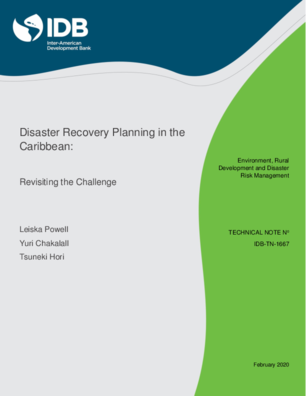Disaster Recovery Planning in the Caribbean: Revisiting the Challenge
Date
Feb 2020
Even though the number of disasters and their catastrophic consequences increase, few governments are well prepared to undertake the recovery efforts necessary to bring affected areas and communities back to normal [as quickly as possible] in the aftermath of a disaster. The economic and social losses associated with disasters remain substantial. The average annual losses from earthquakes, tsunamis, tropical cyclones and river flooding are estimated at US$ 314 billion in the built environment alone.
One of the four pillars of the Sendai Framework for Disaster Risk Reduction, 2015-2030 highlights that building effective recovery governance before a disaster occurs represents a critical opportunity to “Build Back Better”. One way of advancing this is to plan for recovery before disasters happen. The International Recovery Platform, 2012 noted that much can be done pre-disaster to alleviate recovery planning demands after the disaster.
There is consensus among the global DRM community that Pre-disaster recovery planning (PDRP) is a catalyst to effectively address the challenges of planning and implementing successful disaster recovery to ensure long-term social and economic sustainability after a disaster. There are several documented benefits of PDRP in the literature including expediting the recovery process when appropriate structures, policies, plans are prepared and understood prior to a disaster, provides Build back better as a “window of opportunity”, inclusive as it fosters engagement and participation of multiple stakeholders including communities and reduces recovery costs. Notwithstanding these benefits, the wide scale adoption and implementation of PDRP is still incipient and not common practice.
While disasters are a common feature of the Caribbean, there has been little serious reflection on the types of action needed for long-term resilience. In establishing the baseline status of PDRP in the region, it was necessary to determine the presence/existence of a national or sectoral disaster recovery plan or framework. An overwhelming 70 per cent of CDEMA Participating States indicated the absence of a national or sectoral PDRP or framework. However, most of the respondents (90%) are aware of the MNRF that was developed by CDEMA. The findings also show that sixty (60) per cent of jurisdictions have either not commenced or made very little progress (incipient) with implementation (preparing PRDP) using the MNRF guide.
The main barriers that have contributed to the absence of institutionalization of PDRP in the region stems from governance issues related to the existing legal frameworks for disaster risk management (DRM), financing for PDRP implementation, institutional capacities to support recovery planning and the disconnect between PDRP as part of comprehensive DRM and the long-term development goals among decision-makers.
The discussion and recommendations put forward both policy and operational level recommendations that are much needed to strengthen PDRP in the region. At the policy level actions include the strengthening of policies and laws to support Recovery Planning, developing National Disaster Recovery Frameworks, promote business continuity planning of key and financing PDRP implementation. The operational level seeks to establish the necessary systems and capacities pre disaster including research and data for PRDP, capacity building for pre and post disaster recovery planning, strengthening monitoring mechanism and public education campaign to entrench recovery planning.
One of the four pillars of the Sendai Framework for Disaster Risk Reduction, 2015-2030 highlights that building effective recovery governance before a disaster occurs represents a critical opportunity to “Build Back Better”. One way of advancing this is to plan for recovery before disasters happen. The International Recovery Platform, 2012 noted that much can be done pre-disaster to alleviate recovery planning demands after the disaster.
There is consensus among the global DRM community that Pre-disaster recovery planning (PDRP) is a catalyst to effectively address the challenges of planning and implementing successful disaster recovery to ensure long-term social and economic sustainability after a disaster. There are several documented benefits of PDRP in the literature including expediting the recovery process when appropriate structures, policies, plans are prepared and understood prior to a disaster, provides Build back better as a “window of opportunity”, inclusive as it fosters engagement and participation of multiple stakeholders including communities and reduces recovery costs. Notwithstanding these benefits, the wide scale adoption and implementation of PDRP is still incipient and not common practice.
While disasters are a common feature of the Caribbean, there has been little serious reflection on the types of action needed for long-term resilience. In establishing the baseline status of PDRP in the region, it was necessary to determine the presence/existence of a national or sectoral disaster recovery plan or framework. An overwhelming 70 per cent of CDEMA Participating States indicated the absence of a national or sectoral PDRP or framework. However, most of the respondents (90%) are aware of the MNRF that was developed by CDEMA. The findings also show that sixty (60) per cent of jurisdictions have either not commenced or made very little progress (incipient) with implementation (preparing PRDP) using the MNRF guide.
The main barriers that have contributed to the absence of institutionalization of PDRP in the region stems from governance issues related to the existing legal frameworks for disaster risk management (DRM), financing for PDRP implementation, institutional capacities to support recovery planning and the disconnect between PDRP as part of comprehensive DRM and the long-term development goals among decision-makers.
The discussion and recommendations put forward both policy and operational level recommendations that are much needed to strengthen PDRP in the region. At the policy level actions include the strengthening of policies and laws to support Recovery Planning, developing National Disaster Recovery Frameworks, promote business continuity planning of key and financing PDRP implementation. The operational level seeks to establish the necessary systems and capacities pre disaster including research and data for PRDP, capacity building for pre and post disaster recovery planning, strengthening monitoring mechanism and public education campaign to entrench recovery planning.




